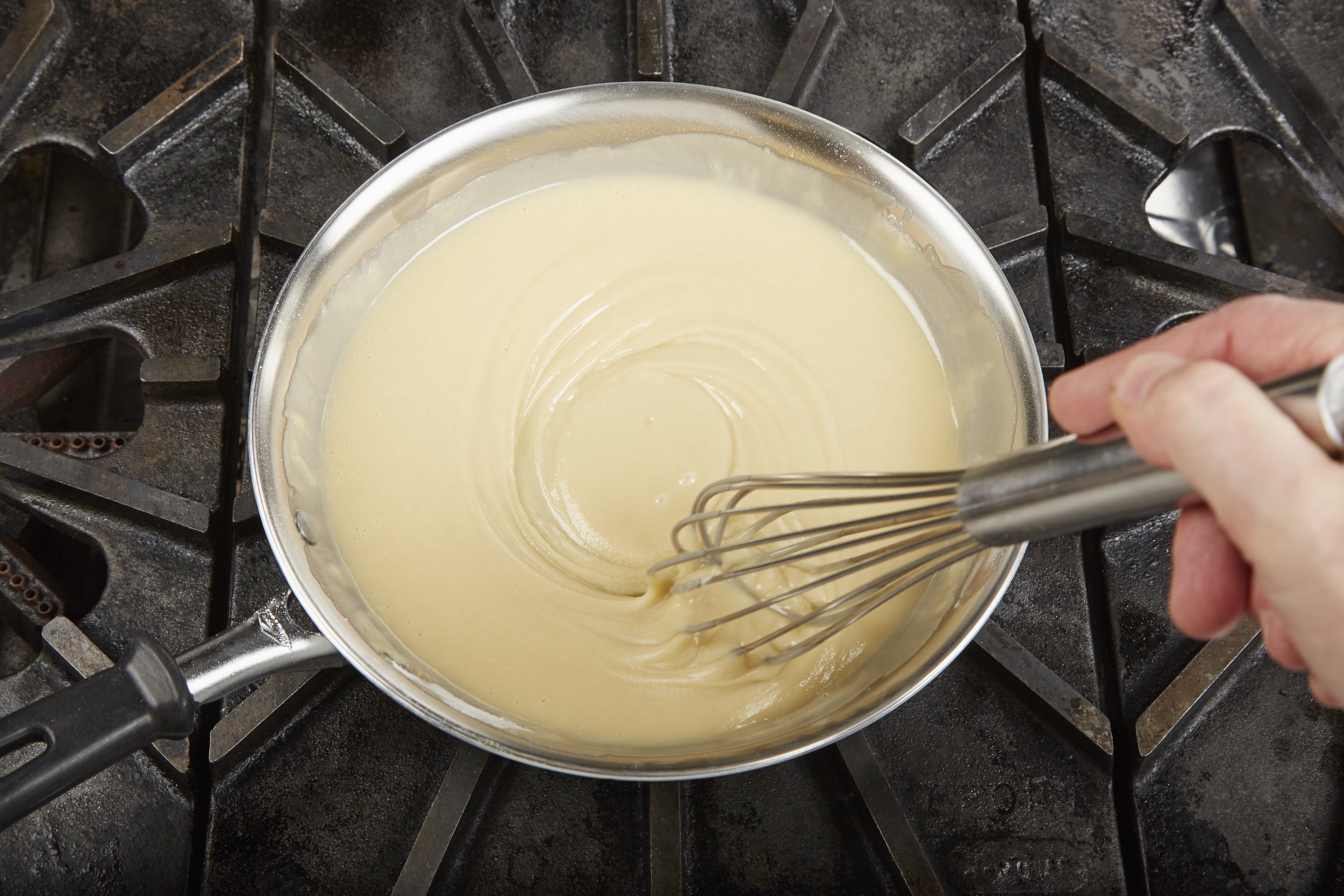Thickening Agents
The goal of thickening a sauce is to add viscosity, texture, and mouthfeel while helping the food to linger on the taste buds. Un-thickened sauces may have a more immediate flavor punch but don’t cling to the tongue unless they are high in gelatin (and glutamates), which is found in meats, poultry, and fish. Thickeners in the form of starches, like flour or cornstarch, add body to a sauce. However, they can mask flavors and require more seasoning to compensate for this difference.
REDUCTIONS, EMULSIONS, AND SUSPENSIONS
Methods for thickening sauces, soups, and stews include reductions, emulsions, and suspensions.
Reduction concentrates liquids and flavors by simmering and reducing the volume through evaporation. In meat-based sauces, naturally occurring gelatins help to add body.
Emulsions, or colloids, occur when wheat or refined starches swell and gelatinize in hot liquids. They are also created when liquids and fats combine and are agitated to make mayonnaise or hollandaise sauce.
Suspensions are created by blending various ingredients into fine particles to create a homogenous mixture, such as in a tomato sauce or bean soup.
REDUCTION SAUCES
Sauces prepared using the reduction method have an intense flavor unobstructed by thickening agents. The simplest sauces are made from rendered pan juices, known as a jus, from roasted or sautéed proteins (meat, poultry, or fish) and enhanced with a prepared stock, wine, or other suitable liquid. These sauces are simmered to reduce the liquid and concentrate the flavors. A glace, or glaze, is a reduced stock cooked to a syrup-like consistency, resulting in a viscous, intensely flavored sauce.
EMULSIONS
Wheat flour is used extensively in professional kitchens as a thickening agent. Although it can be combined with water to create a whitewash, it is more commonly mixed with fat, which surrounds the starch granules and prevents clumping when added to hot liquids. Roux is a combination of equal parts by weight of flour and fat cooked to gelatinize the flour before use. A beurre manie is an uncooked roux consisting of equal parts by volume of softened butter and blended flour.
WHEAT FLOUR: THICKENING WITH ROUX
Four types of roux are classified by color and length of cooking time, from white to blonde and brown to black. Although a basic ratio for roux is equal parts fat and flour by weight, the extended cooking time for a dark roux reduces the flour’s thickening power, so the ratio is adjusted up to three parts flour to two parts fat. Clarified butter is often used because of its preferred flavor, but vegetable oils or other rendered animal fats (chicken, pork, or duck) can also be used. A roux should be stiff and not runny. In a professional kitchen, a roux is often prepared in batches and held ready to use when needed.
White or Pale Roux
Lighter rouxs, like white and blond, are used in white sauces, like Béchamel and Velouté while darker rouxs are used in brown sauces and southern American cuisines like Creole and Cajun cooking. Remember that prolonged heat will cause flour grains to close up and not swell as much when dispersed in a liquid, so the more a roux is cooked, the less thickening power it possesses.
White or Pale Roux
Uses: Cream soup, Béchamel sauce
Melt fat in a saucepan and add an equal part by flour weight.
Stir while cooking for about 5 minutes, careful not to let the roux color.
Blond Roux
Blond Roux
Uses: Velouté sauce, soups, white stews
Melt fat in a saucepan and add an equal part by weight of flour.
Cook for about 10 minutes to give it a gold color.
Brown Roux
Brown Roux
Uses: Espagnole sauce, brown stews and braises
Use a 3:2 ratio of flour to fat.
Melt fat in a saucepan and add equal part by weight of flour.
Cook while stirring for 30 minutes to give it a rich brown color.
Alternately cover with a tight lid and cook in a 350˚F (177˚C) oven.
Black Roux
Black Roux
Uses: Gumbo, Cajun Cuisine
Cook while stirring to give it a dark brown-to-black color.
Cook for about 60 minutes to give it a rich color.
Alternately cover with a tight lid and cook in a 350˚F (177˚C) oven.
OTHER WHEAT-BASED OPTIONS
Brown flour, also called a dry roux, is used in Cajun and Caribbean cooking as a thickening agent. It is prepared in a cast iron skillet on the stove with continuous stirring or placed on a sheet pan in a 350°F (175˚C) oven for 1 hour and stirred about every 15 minutes. The flour is added directly to the liquid or combined with fat to create a roux. It is shelf-stable and can be combined with fats to develop an instant brown roux.
Beurre manié —Also called kneaded butter, beurre manié is equal parts of softened butter and flour that are worked together into a smooth paste. It is used at the last minute to adjust the consistency of sauces, soups, and stews. Add a little at a time and allow to cook so the flour can swell and absorb liquid. Since the flour is raw, simmering it for a few minutes is a good idea to cook out the taste.
Bread Crumbs—Cooked wheat products, including bread, crackers, and cookies, crumbled or pulverized, are economical ways to thicken soups, sauces, and stews. This practice has been documented since ancient Roman times and is useful for leftover stale bread.
ROUX TO LIQUID RATIOS
For medium-thickness sauces, use a ratio of 8 parts liquid to one part roux, equal to 16 oz. (450 g) of roux for each gallon (4 liters) of liquid. The amount of roux will vary depending on the desired thickness (see chart). It also depends on how long the roux is cooked. That’s because during the cooking process, the grains of the flour swell, and the cell structure weakens under prolonged heat, causing the grains to collapse. A brown roux loses up to 50% of its thickening power, requiring more roux. That’s why the flour ratio is increased when preparing a darker roux.
When thickening a soup or sauce, the liquid may be added to the roux, or the roux may be added to the liquid. Although the roux can be used cold or warm, it’s best not to have both the liquid and the roux hot because the roux can become lumpy in the liquid. Wheat flour needs about 20 minutes to swell and achieve its full thickening potential, so be patient and allow it to cook sufficiently.
Refined Vegetable Starches
Refined starches are popular as thickening agents because they are lighter than a roux, neutral-flavored, and swell quickly when added to hot liquids. Refined starches, including arrowroot, cornstarch, potato starch, and rice flour, are also preferred alternatives for gluten-intolerant diets. These starches are mixed with water to create a slurry that is added at the end of the cooking process because prolonged heat weakens their power.
Preparing a Slurry
Use a ratio of 16 parts of the liquid to be thickened to 1 part starch by volume (see chart). Always combine the starch with an equal volume of cool water before adding it to the hot liquid. Heat the liquid to be thickened to a simmer and whisk the slurry into the sauce. The sauce will thicken once the liquid returns to a boil.
Combine Starch and Water
Prepare a slurry by combining equal parts by volume of the starch with cool water.
Heat Liquid
Heat the liquid to a simmer.
Combine Slurry and Hot Liquid
To prevent lumps, stir continuously while whisking in the slurry.
Simmer and Adjust
Return to a simmer until the sauce thickens.
The sauce will thicken within about 1 minute if the liquid is fully boiled.
Adjust with more starch if necessary.
THICKENING WITH WARM EMULSIONS
Whisking clarified butter into egg yolks to create a Hollandaise Sauce
Warm emulsions mix fats and liquids that generally do not easily combine. Rapidly whisking a liquid while slowly adding fat causes the fat molecules to split into tiny droplets that adhere to the liquid, creating a thick viscosity. Liquids and fats, when combined, create temporary emulsions, but adding ingredients like egg yolks, reduced cream, or spices will stabilize these mixtures. Sauces like Hollandaise and Béarnaise are two examples of egg yolk and butter emulsions, and a beurre blanc sauce is an example of a liquid and butter emulsion stabilized with cream. Mayonnaise is an uncooked version. These sauces are time and temperature-sensitive and are usually prepared as needed just before the start of service.
Warm emulsion sauces can’t be held in a hot box or steam table because the temperatures are usually too high, causing them to separate. Instead, keep in a warm bath or insulated at 120°F/49˚C in an insulated food container and discard after a maximum of 4 hours.
LIAISON OF EGG YOLKS AND CREAM
A liaison is composed of egg yolks and cream and is used to enrich and thicken soups, sauces, and stews at the end of the cooking process. Once a liaison is added, never allow it to boil because the egg yolks will curdle and have a grainy appearance. Use a ratio of 4 parts cream to 1 part egg yolks.
Dairy Products
Butter is an emulsion in itself, swirled into sauces at the end of the cooking process, known as Monter au Beurre. Butter will thicken slightly, but it also adds richness.
Cream – Added to enrich a sauce, cream as a thickener must be reduced to provide viscosity to liquids. It works best when reduced by about one-third of its volume to concentrate fat globules to about 55% of the total volume.
THICKENING WITH SUSPENSIONS
Grains, legumes, root vegetables, nuts, and seeds are gluten-free thickening agents used in various ethnic and vegetarian preparations. Raw rice is a traditional thickener in bisque soup, while raw diced potatoes are a natural thickener in cream soups. For kitchen efficiency, leftover rice and potato purees can be repurposed into soups rather than thrown out. Pureed fruits and vegetables are the basis for classic Italian tomato sauces and French coulis, while nuts and seeds are used in African and vegetarian cooking.











